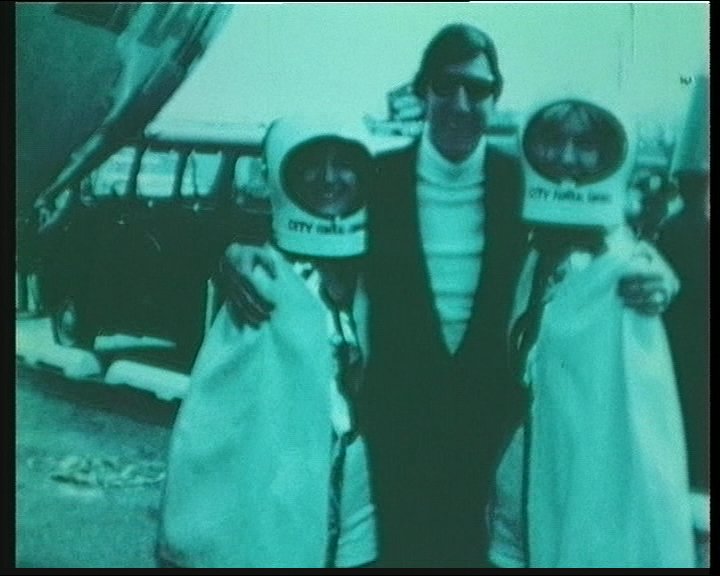Futuro: A New Stance for Tomorrow©Kinotar
by Lorenza Pignatti
There’s no mention of the future in these initial decades of the third millennium. Future stances and forecasts have been swallowed by temporality in the form of an eternal now that extends into the future, with the same system of values and conventions. No radical transformation is narrated or imagined, just the presentation of new technological communication devices creating new excitement. Devices that challenge people’s analogical means of communication. People who are still too human to compete with the speed set by the algorithms and incessant info-production stimulation present in contemporary society.
In the 1960s and 1970s, technical-scientific and cultural innovation went forth hand-in-hand. Future forecasts were based on trends that developed in a linear way and upon which individuals could intervene with political, economic, design type choices. Various works by the Finnish artist and filmmaker Mika Taanila (born in 1965 in Helsinki) investigate this precise moment in history, when a future imaginary determined new scenarios in varying forms of knowledge: literature, design, music. It matters little if utopian stances at that time never became a reality; for Taanila what matters is to single out the exchange and connections that exist between science, technology, and the collective imaginary. As in the film Futuro: A New Stance for Tomorrow that covers the story of the “Futuro House,” a pre-fabricated housing unit made in plastic and designed/developed by the Finnish architect Matti Suuronen in 1968.
Futuro: A New Stance for Tomorrow©Kinotar
They turned into 1960s/1970s icons thanks to their shape that calls to mind flying saucers. It represents the seduction and trust typical in those years of space exploration and the importance attributed to leisure time, since this kind of housing was low-cost and accessible to everyone. The film – made with non-professional footage, archive material, and interviews – discusses the wonder that still today these homes can arouse, as they have become cult objects. The gasoline crisis in the early 1970s interrupted the fabrication of the “Futuro House” because they began to cost too much. Some have survived while others have been destroyed. The few that remain have been purchased by institutions like the Central Museum of Utrecht, the Boijmans Museum in Rotterdam, the University of Canberra, or by artists like Carsten Holler.
As the geographer Franco Farinelli reminds us, it is precisely at the moment when the entire world looks upon man’s landing on the moon, in the summer of 1969, that great changes occur on the Earth. “It had nothing to do with the space (understood as cosmos) race, of its annexation to the celestial body, but instead of its end (the end of space intended as a modern world model).” In fact, during that time the first computers in 4 American universities were connected through Arpanet, the network that later gave rise to Internet. At that time at the University of Helsinki, Erkki Kurenniemi – the techno visionary, robotics expert, programmer, and pioneer in the field of electronic music, experimental film, and media art – tested the use of visors and electronic prostheses to recreate the experience of perception and the senses, as demonstrated by the music and film software he made (over a dozen).
Born in 1941 in Hämeenlinna, Kurenniemi is considered one of the most important pioneers of electronic music in Finland. He is universally recognized for the electronic instruments he designed in the 1960s and 1970s. He was mainly interested in cybernetics and artificial intelligence. He theorized that in a near future, a quantum computer could create, through sophisticated algorithms, virtual avatars of human beings thanks to elaborated visual and textual information. In order to realize his virtual avatar, Kurenniemi collected and recorded fragments from his day-to-day life: not the extraordinary events, but rather shards of life, his long travels in the night, conversations with friends and colleagues, sentimental relationships. The Future Is Not What It Used To Be is the film Taanila made with found footage and archive material on the life and work of the brilliant Kurenniemi.
The Future Is Not What It Used To Be©Kinotar
Another important aspect of Taanila’s works is the bond between image and sound investigated in multiple video installations including A Physical Ring and Optical Sound. The former offers an amateur film found in the Finnish Film Archive on a quantum physics test. The goals of this test, conducted in 1940 by an unknown scientist, have left no trace, but this is of little importance, seeing that it has become a kinetic work of art. Instead, Optical Sound shows a different use for the dot matrix printer. This technology has by now become obsolete with respect to the more contemporary and seductive 3D printers, which can however be transformed into low-tech musical instruments. Through sophisticated and complex filming and recording techniques, Taanila explores the aesthetic and sound qualities of dot matrix printers.
The Future Is Not What It Used To Be©Kinotar
LORENZA PIGNATTI, “THE TIME MACHINES OF MIKA TAANILA” WAS ORIGINALLY PUBLISHED IN FRUIT OF THE FOREST , 2015. ©FORTINO EDITIONS ©THE AUTHOR



